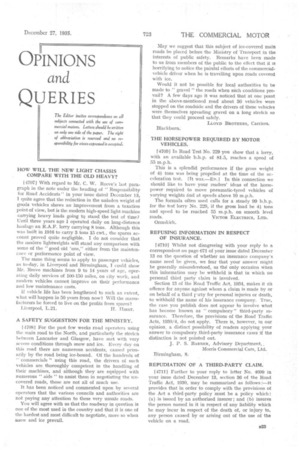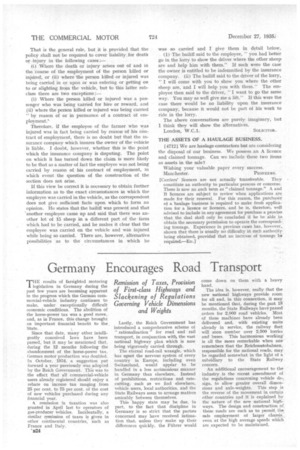OPINIONS and
Page 29

Page 30

If you've noticed an error in this article please click here to report it so we can fix it.
QUERIES
HOW WILL THE NEW LIGHT CHASSIS COMPARE WITH THE OLD HEAVY?
[4707] With regard to Mr. C. W. Reeve's last paragraph in the note under the heading of "Responsibility for Road Accidents" in your issue dated December 13, I quite agree that the reduction in the unladen weight of goods vehicles shows an improvement from a taxation point of view; but is the modern high-speed light machine carrying heavy loads going to stand the test of time? Until three years ago I operated daily on long-distance haulage an R.A.F. lorry carrying 8 tons. Although this was built in 1916 to carry 3 tons 15 cwt., the spares account proved quite negligible. I do not consider that the modern lightweights will stand any comparison with some of the "good old 'uns," either from the maintenance or performance point of view.
The same thing seems to apply to passenger vehicles, as to-day, in Liverpool and Birmingham, I could show Mr. Reeve machines from 9 to 14 years of age, operating daily services of 100-150 miles, on city work, and modern vehicles cannot improve on their performance and low maintenance costs.
If vehicle life has been lengthened to such an extent, what will happen in 50 years from now? Will the manufacturers be forced to live on the profits from spares?
Liverpool, L.21. H. IfIRST.
A SAFETY SUGGESTION FOR THE MINISTRY.
[4708] For the past few weeks road operators using the main road to the North, and particularly the stretch between Lancaster and Glasgow, have met with very severe conditions through snow and ice. Every day on this road there are numerous accidents, caused primarily by the road being ice-bound. Of the hundreds of " commercials " using this road, the drivers of such vehicles are, thoroughly competent in the handling of their machines, and although they are equipped with numerous " aids " to assist them in negotiating the icecovered roads, those are not all of much use.
It has been noticed and commented upon by several operators that the various councils and authorities are not paying any attention to these very unsafe roads.
You will agree with us that the roadway in question is one of the most used in the country and that it is one of the hardest and most difficult to negotiate, more so when snow and ice prevail. May we suggest that this subject of ice-covered main roads be placed before the Ministry of Transport in the interests of public safety. Remarks have been made to us from members of the public to the effect that it IS horrifying to notice the painful efforts of the commercialvehicle driver when he is travelling upon roads covered with ice.
Would it not be possible for local authorities to be made to" gravel "the roads when such conditions prevail? A few days ago it was noticed that at one point in the above-mentioned road about 30 vehicles were stopped on the roadside and the drivers of these vehicles were themselves spreading gravel on a long stretch so that they could proceed safely.
LLOYD BROTHERS, Carriers. Blackburn.
THE HORSEPOWER REQUIRED BY MOTOR VEHICLES.
[4709] In Road Test No. 229 you show that a lorry, with an available b.h.p. of 81,5, reaches a speed of 55 m.p.h.
This is a splendid performance if the gross weight of 4itons was being propelled at the time of the ac
celeration test. [It was.—En.] In this connection we should like to have your readers' ideas of the horsepower required to move pneumatic-tyred vehicles of varying weights And at speeds above 10 m.p.h.
The formula often used calls for a steady 99 b.h.p. for the test' lorry No. 229, if the gross load be 41 tons and speed to be reached 55 m.p.h. on smooth level
roads. VICTOR ELECTRICS, LTD. Ormskirk.
REFUSING INFORMATION IN RESPECT OF INSURANCE.
[4710] Whilst not disagreeing with your reply to a correspondent on page 671 of your issue dated December 13 on the question of whether an insurance company's name need be given, we fear that your answer Might be generally misunderstood, as thd only occasion When this information may he withheld is that in which no personal third party claim is involved.
Section 13 of the Road Traffic Act, 1934, makes it an offence for anyone against whom a claim is made by or on behalf of a third rArty for personal injuries or death, to withhold the name of his insurance company. True, the case you publish does not appear to involve what has become known as " compulsory " third-party insurance. Therefore, the provisions of the Road Traffic Acts, 1930/4, do not apply. There is, however, in our opinion, a distinct possibility of readers applying your answer to compulsory third-party insurance cases if the distinction is not pointed out.
J. P. S. BARBF.R, Advisory Department,. Morris Commercial Cars, Ltd. Birmingham, 8;
REPUDIATION OF A THIRD-PARTY CLAIM.
[4711] Further to your reply to letter No. 4690 in your issue dated December 13, section 36 of the Road Traffic Act, 1930, may be summarized as follows :—.1t provides that in order to comply with the provisions of the Act a third-party policy must be a policy which : (a) is. issued by an authorized insurer ; and (b) insures the person named in it in respect of any liability which he may incur in respect of the death of, or injury to, any person caused by or arising out of the use of the vehicle on a road. That is the general rule, but it is provided that the policy shall not be required to cover liability. for death or injury in the following cases
(i) Where the death or injury arises out of and in the. -course of the employment of the person killed or initired, or (ii) where the person killed or injured was being carried in or upon or was entering or getting on to or alighting from the vehicle, but to this latter subclass there are two exceptionS
(i) Where the person killed or injured was a passenger who was being carried for hire or reward, and (ii) where the person killed or injured was being carried " by reason of or in pursuance of a contract of employment'.
Therefore, if the employee of the farmer who was injured was in fact being carried by reason of his con7 tract of employment, there is no doubt but that the insurance company which insures the owner of the vehicle is liable. I doubt, however, whether this is the point which the insurance company is disputing. The point on which it has turned down the claim is more likely to be that as a matter of fact the employee was not being carried by reason of his contract of employment, in which event the question of the construction of the section does not arise.
If this view be correct it is necessary to obtain further information as to the exact circumstances in which the employee was carried in the vehicle, as the correspondent does not give sufficient facts upon which to form an opinion. He states that the bailiff was present and that 'another employee came up and said that there was another lot of 15 sheep in a different part of the farm which had to be carried, and he makes it clear that the employee was carried on the vehicle and was injured while being so carried. There are, however, alternative possibilities as to the circumstances in which he was so carried and I give them in detail below.
(1) The bailiff said to the employee, "you had better go in the lorry to show the driver where the other sheep are and help him with them." If such were the case the owner is entitled to be indemnified by the insurance company. (ii) The bailiff said to the driver of the lorry, "I will come with you to show you where the other sheep are, and I will help you with them." The employee then said to the driver, "I want to go the same way. You may as well give me a lift." If this were the case there would be no liability upon the insurance company, because it would not be part of his work to ride in the lorry.
The above conversations are purely imaginary, but I think they will show the alternatives.
London, W.C.1. SOLICITOR.
THE ASSETS OF A HAULAGE BUSINESS.
[4712} We are haulage contractors but are considering the disposal of our business. We possess an A licence and claimed tonnage. Can we include these two items as assets in the sale?
Wishing your valuable paper every success.
Manchester. PIONEERS.
[Carriers' licences are not actually transferable. They constitute an authority to particular persons or concerns. There is now no such term as "claimed tonnage." A and B licences are subject to review when applications are made for their renewal. For this reason, the purchaser of a haulage business is required to make fresh application for a licence or licences, and he is, therefore, well advised to include in any agreement for purchase a proviso that the deal shall only be concluded if he be able to obtain the necessary permission to operate the corresponding tonnage. Experience in previous cases has, however, shown that there is usually no difficulty in such authority being obtained, provided that no increase of tonnage berequired.—En.]












































































